FRIDA KAHLO and the Blue House
The exhibit “FRIDA KAHLO and the Blue House” presents a selection of color photographs of the architecture and interior spaces of the Blue House created by Cristina Kahlo as well as vintage black and white photographs taken by Diego Rivera, Antonio Kahlo, Lola Álvarez Bravo, Florence Arquin, and Juan Guzmán.
About the Artist – CRISTINA KAHLO
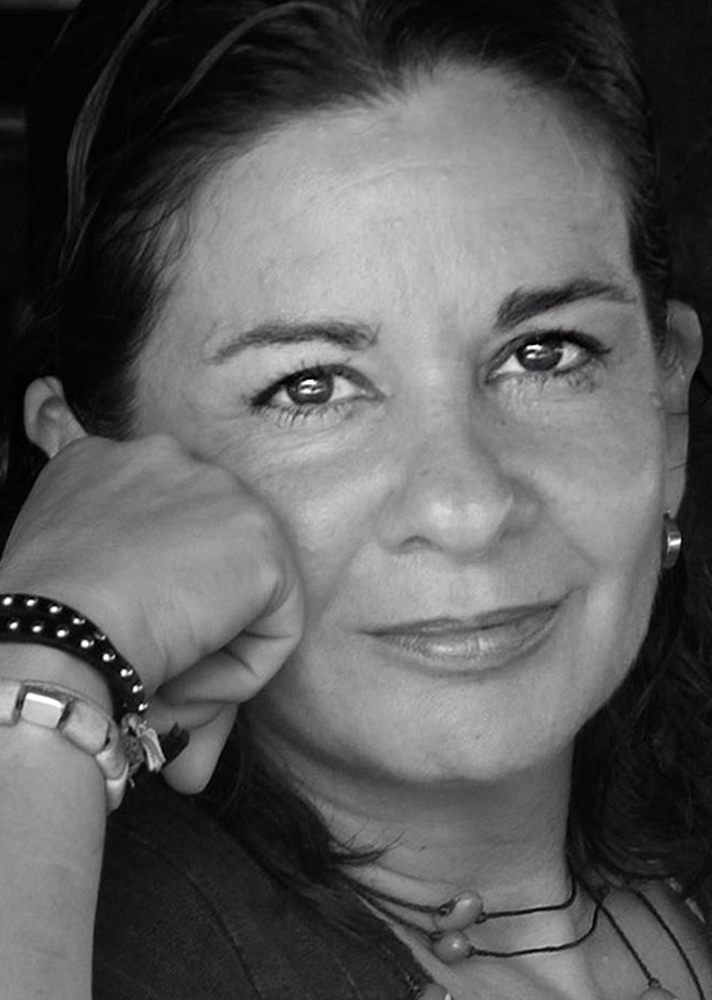
Cristina Kahlo (b. 1960) lives and works in Mexico City. Throughout her life, she has tackled different aspects of documentary photography. She was the founder and director of the Galería Alternativa (1983 – 1985) and later, in partnership with Juan Coronel Rivera, of the Fotogalería Kahlo-Coronel (1986 – 1991) in Mexico City. As an independent curator of photography, she has worked for important international museums, including Martin-Gropius-Bau in Berlin, Germany; the Kunstforum in Vienna, Austria; the Palazzo Ducale in Genoa, Italy; and the Museum of the Palace of Fine Arts in Mexico City, among others. She is the grandniece of Frida.
FRIDA KAHLO AND THE BLUE HOUSE
Magdalena Carmen Frida Kahlo y Calderón (1907 – 1954)
(Frida’s complete full name)
Diego Rivera (1886 – 1957)
Imagine traveling through iconic painter Frida Kahlo’s Blue House (La Casa Azul)—her birthplace, where she lived with husband and painter/muralist *Diego Rivera, her studio, and where she died. Rivera donated the eye-popping blue dwelling as a museum dedicated to her life and work, one of the most-visited tourist attractions of Mexico City. Casa Azul was built in 1904 by Frida’s father Guillermo Kahlo.
You’re invited to take this stunning virtual journey in the latest exhibition at El Museo Latino. Frida’s grandniece, Cristina Kahlo herself a renowned photographer, created this vivid and revelatory installation of photographs of La Casa Azul. The more than 60 images of the architecture and interior spaces of the Blue House—as well as vintage black and white photographs taken by Diego Rivera, Antonio Kahlo, Lola Álvarez Bravo, Florence Arquin, and Juan Guzmán—transport you into these special spaces, her time, and her circle of friends and family. You’ll also see walls painted in vibrant “Frida colors” and some of her memorable phrases (“Feet, what do I need you for when I have wings to fly?”)
The photographs in the current exhibit document aspects of the life and times and friends of Frida Kahlo. Here are just a few examples:
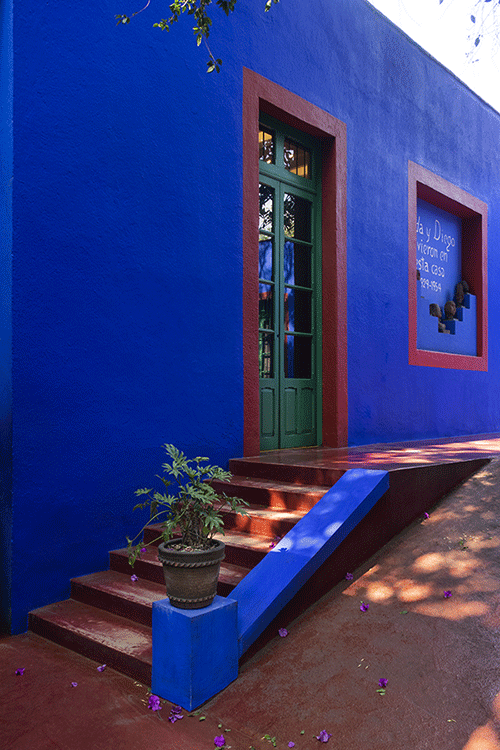
Courtyard Entrance to the Blue House
2023; photo taken by Cristina Kahlo
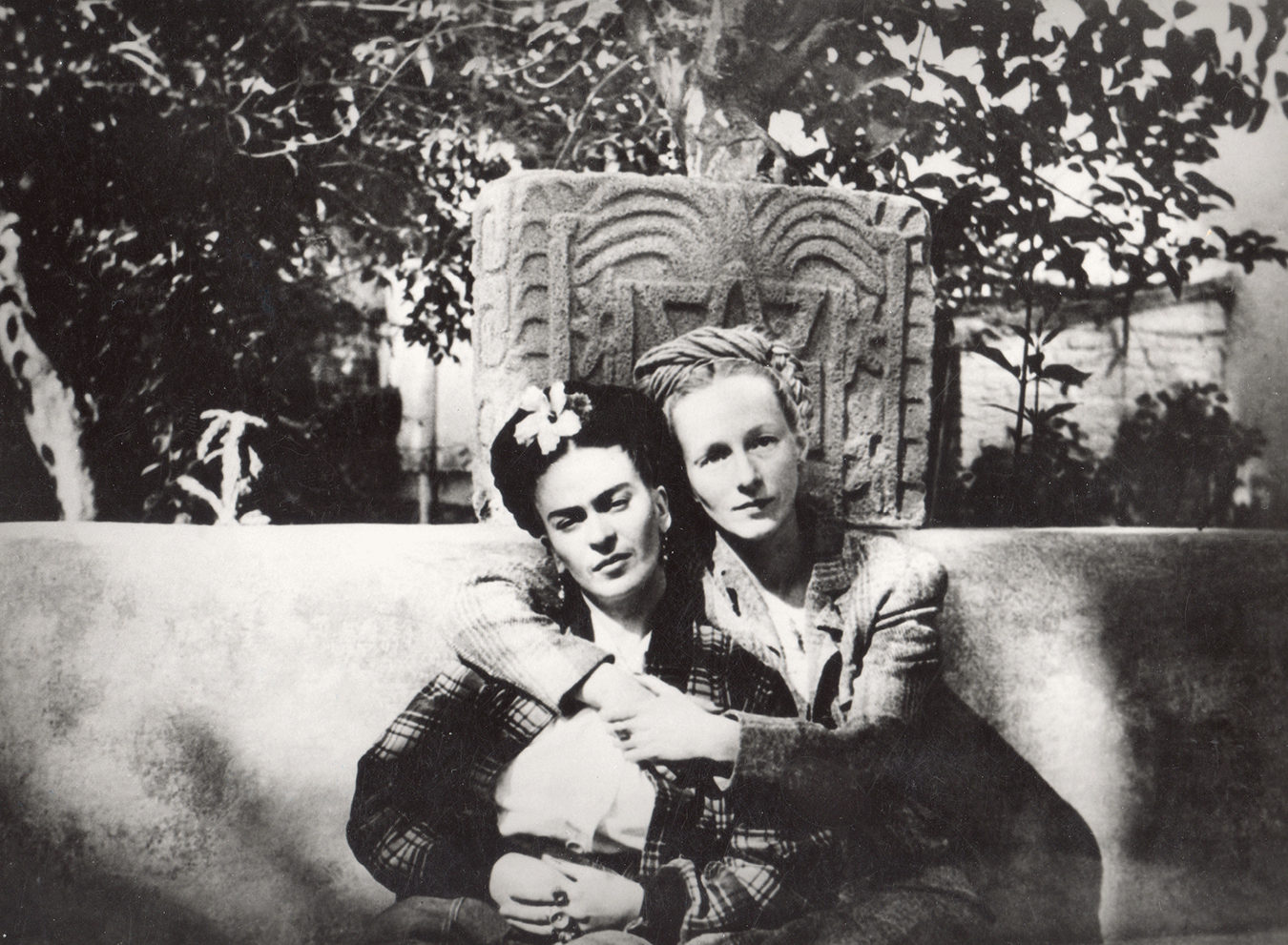
Title: Frida and Emmy Lou Packard in Coyoacán 1941; photo taken by Diego Rivera
The Blue House is located in Coyoacán (a neighborhood in Mexico City), the place where Frida was born. Emmy Lou Packard (1914 – 1998) was a painter, muralist, and printmaker. After her husband died in 1939 she went to live with Frida and Diego and worked as his studio assistant.
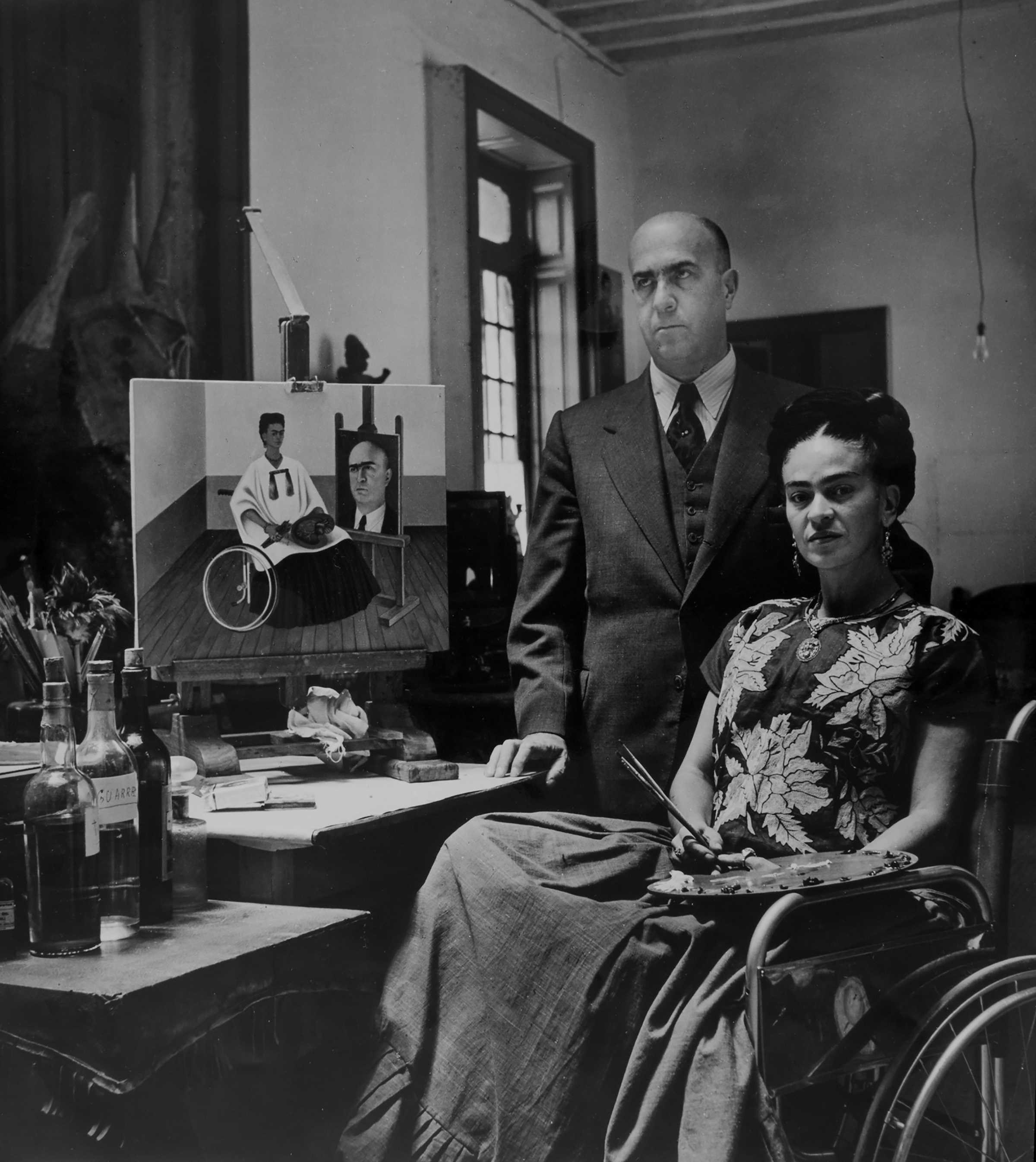
Title: Dr. Juan Farill* and Frida Kahlo next to her painting "Self-Portrait with Dr. Farill” 1951; photo taken by Gisèle Freund**
This remarkable photo is a sort of “multiple exposure.” It shows Frida in a wheelchair, with the physician behind her, along with a painting she made in 1951 (her first work post-surgeries that year) of herself in a wheelchair, and behind her, a painting of Dr. Farill. (Notice that she gave him a “unibrow” like she herself had.) He had operated on her back seven times to relieve her severe back pain, requiring nine months of hospitalization. She later said: “He saved me.”
Living with permanent pain was a lifelong fact of life for Frida. Many years before, in a horrific streetcar crash in 1925, the 18-year-old Frida suffered multiple injuries that ravaged her body, including a fractured pelvic bone, a punctured abdomen and uterus, three breaks in her spine, multiple fractures in her right leg, a crushed right foot, broken collarbone, three displaced vertebrae, and a dislocated shoulder. Over the course of her life, she underwent more than two dozen surgeries. Part of her treatment included various corsets (the current exhibit includes a photo of one of them). Her physical disabilities became part of her persona—her life and her art.
*Juan Farill (1902 – 1973)
Dr. Farill was an orthopedic surgeon and also a painter. He not only performed the last seven of Frida’s spinal surgeries, but also amputated gangrenous toes on her right foot.
** Gisela Freund (1908 – 2000) aka Gisèle Freund
Award-winning German-born French photographer and photojournalist renowned for her photos of artists and writers. Frida could be seen in a number of exhibits of Freund’s work.
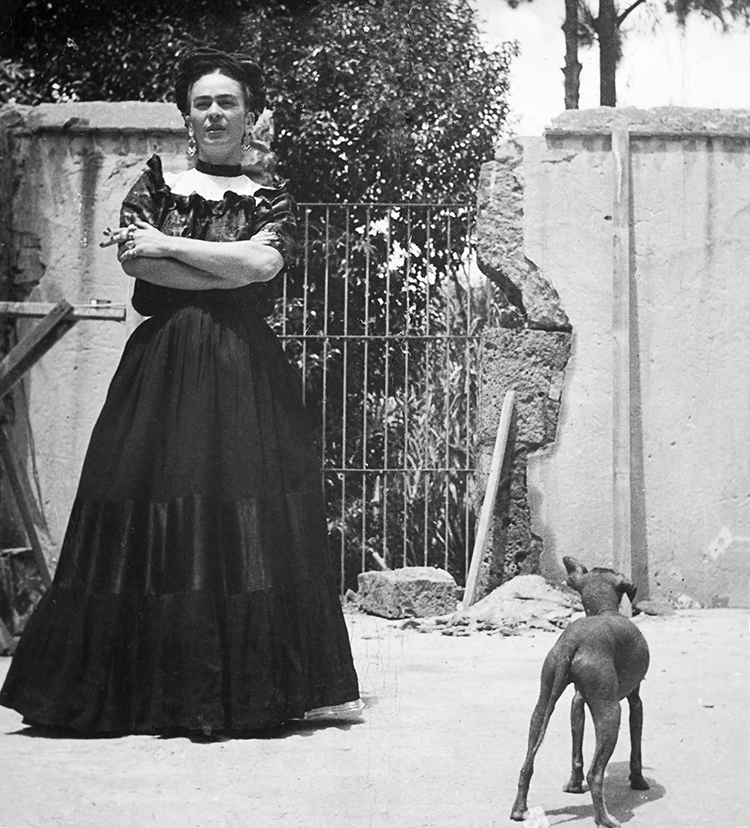
Title: Frida with Xoloescuintle dog*
c. 1944; photo taken by Lola Álvarez Bravo**
*Xoloescuintle, a hairless breed of dog (the name comes from “Xolot” death and “itzcuintli” “dog”) named after the Aztec canine deity and guardian of the underworld. Frida and Diego loved the breed, and their favorite dog was called Señor Xolot.
**Lola Álvarez Bravo (1903 – 1993)
Lola Álvarez was a photojournalist, professional portraitist, and commercial photographer. Her work was also recognized and prized as fine art. She was a lifelong friend of Frida’s and internationally renowned for her photographs. According to Margaret Hooks, Lola Álvarez Bravo took the last picture of the artist, “Frida Kahlo on her Deathbed” in 1954, stating that “according to Kahlo's wishes, she was dressed in an outfit she had selected, her nails were painted, and hair braided, and her favorite jewelry adorned her neck and fingers.”
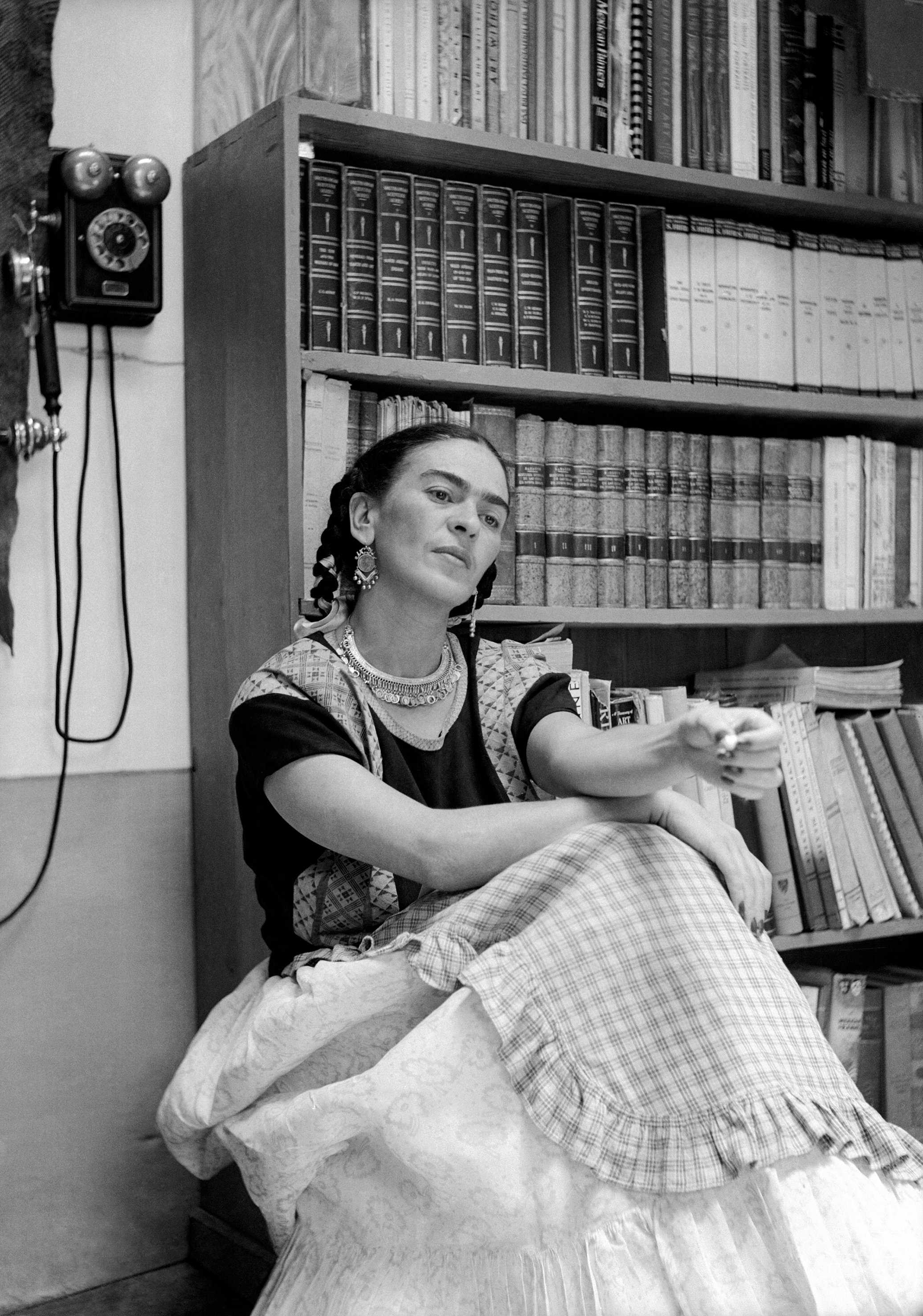
Title: Frida with a telephone in her studio
c. 1950; photo taken by Antonio Kahlo*
*Antonio Kahlo was Frida’s nephew and the father of Cristina Kahlo, Blue House exhibit curator. He was an amateur photographer who introduced Cristina to photography at about age 10 or 11—laying the foundation of her love of the art form. Antonio was only 42 when he died.
Gallery Talk: “Frida Kahlo: A Living Passion” by Gloria Flores, PhD
Gloria Flores is a visiting assistant professor of Spanish-Mexican Literature in the Department of Modern Languages & Literatures at the University of Nebraska at Lincoln and an affiliated member of the dance faculty. Herself a dance performer and choreographer, her primary interest is Mexican literature and cultural studies. Prof. Flores, like other women growing up in Mexico, was exposed at an early age to Frida Kahlo…to look up to and admire the artist and the woman. In her gallery talk, she will discuss the many interpretations of the word “passion” as manifest in Frida’s home Casa Azul, her art, her complicated relationship with Diego Rivera, and her political life and how these aspects of “a living passion” surpassed Frida herself, continuing to have an impact on people both inside and outside of Mexico.
2May 25, 1:30pm - Gallery Talk: “Letters of Love and Pain: Frida’s correspondence” by Sarah Banderas Martinez, doctoral candidate.
Sarah Banderas Martinez is a PhD candidate in Modern Languages & Literatures—Spanish at the University of Nebraska at Lincoln. Her research is focused on Latin American humor. Her presentation at the Museo will relate to Frida’s fraught, toxic relationship with the love of her life, Diego Rivera. She was an avid correspondent, writing to Diego things she couldn’t verbalize to him directly. And her words often betray her insecurity. In a July 1935 letter she wrote: ”All this…has simply made me understand better that I love you more than my own skin, and that even though you don’t love me as much, you love me a little anyway—don’t you? If this is not true, I’ll always be hopeful that it could be, and that’s enough for me…Love me a little. I adore you. Frida” Her painful life was a central theme in her paintings and words.
